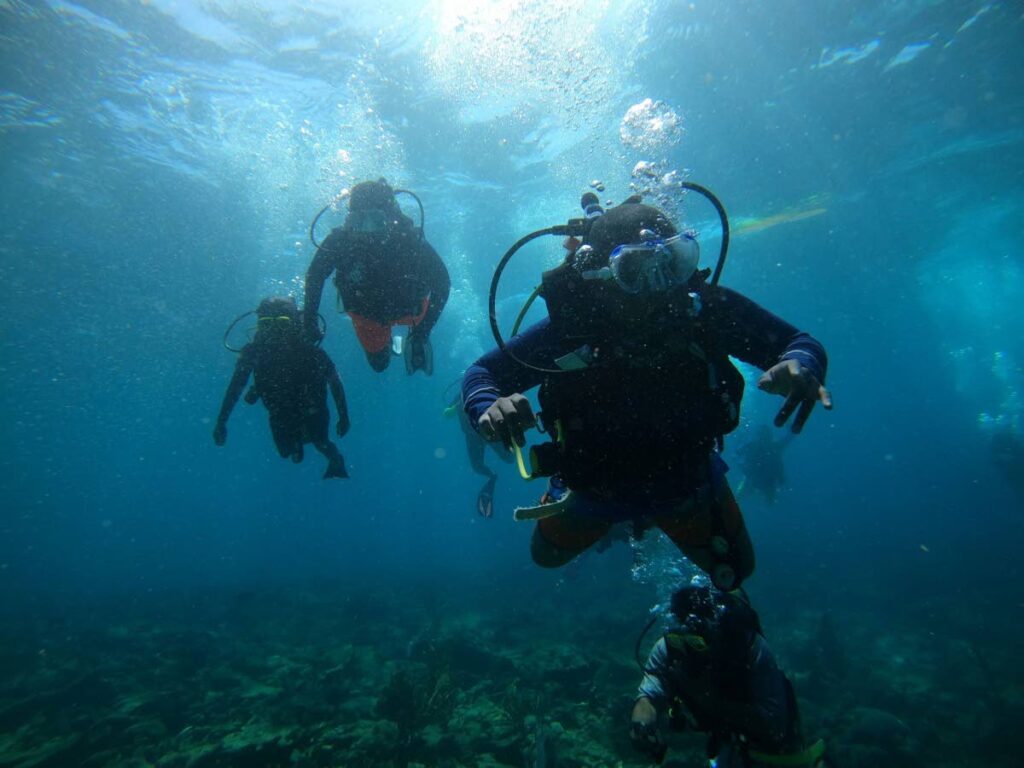ASJA Boys' Dive Club learns value of coral reefs

Dr Anjani Ganase advocates diving education for everyone who lives by the sea or wants to be in the sea. The sea makes islands livable.
We arrived at Speyside around 9 am. The sun was out, and the conditions were perfect for diving. Aquamarine water wrapped around Goat Island and Little Tobago. There was a bustling excitement at the dive shop. Dive suits were being fitted, forms were being signed and eager parents were on the sidelines watching on.
This weekend, I was going out diving for the first time with the ASJA Boys' Scuba Diving and Reef Conservation Club.
As a coral reef scientist in Trinidad and Tobago, I’m always keen to show students what I do and excited to foster interest in the fields of marine science. Life on islands requires us to see the ocean as part of our territory, our responsibility and culture.

We only had a couple days to prepare, two lectures in the week prior, but I was less interested in what they remembered, and more curious to see how they would literally perform simple tasks “under pressure.”
With Mrs Farah Hosein-Bose, geography teacher and a dive enthusiast herself, we were a group of 11 diving together. We were hosted by Tobago Dive Experience, run by Sean Robinson. He is a veteran teacher of diving, and along with his team of dive masters, took charge of keeping the students safe on the boat and underwater.
Diving is a skill in which the methods of breathing, buoyancy and navigation have to become second nature, and more opportunities to dive mean more experiences.

For marine scientists, diving is the mode of doing research underwater, different from recreational diving. The marine scientist descends into the water with a purpose of completing tasks before the air runs out.
We use several tools for measuring and recording as much information as possible. These allow us to do post-diving analysis of imagery, water samples, genetic testing and a multitude of assessments.
The students of the dive club are encouraged to experience a tiny snippet by using tools such as underwater cameras, writing slates and measuring tapes to collect and record information.

Challenges included trying to communicate with each other on who was doing what during the dive, anticipating the next dive. Soon, roles were established, and the boys were able to successfully survey a section of the coral reefs.
The ASJA Boys' Dive Club was established in 2016, founded by the club co-ordinator, and now school principal, Mr Faeid Ali, with a goal of building environmental awareness of our islands and the marine environment.

His philosophy of building respect and stewardship for nature is foundational to all aspects of the school community. Every student is trained to open-water certification and eventually progresses to advanced open-water certification to build different diving experience.
Advanced certification teaches specific skills, such as deep diving to 100 feet, navigation, drift diving and night diving. Some members even move on to rescue-diving certification, which teaches divers to be able to assess and carry out dive emergency response, including training in CPR and in-water and surface rescues.
While diving is a core component of the club’s activities, students also receive a number of lectures from marine professionals, among them experts in marine turtles, coral reefs science, environmental management and diving safety.

The students volunteered for beach clean-ups, recycling programmes, tree planting and even activities to reduce the carbon footprint at school.
There is an understanding that healthy landscapes contribute to healthy seascapes. Of course, the lionfish programme is their members’ particular interest; they are keen hunters, and those who have mastered diving learn about the invasive lionfish and the impacts on the reefs. They are taught to spear the lionfish responsibly, clean it and prepare the fillets for a tasty meal.
Many of these diving experiences have been guided by Alvin Douglas (Frontier Divers) and Ron Tiah (Dive TnT), who have collectively trained over 100 members in PADI certification to date. The current membership is at its largest, with 40 students taking part in club activities.
This was their first-time experience diving in Speyside, an area renowned for whipping currents and requiring advanced diving experience.
However, for our exercises, we sought calm conditions and good visibility to be able to focus the experience on exploring the reef benthos and identify corals, sponges, sea fans and other reef creatures.

While divers often understand the value of coral reefs, it is difficult for them to identify what exactly is a coral. This is especially common in the Caribbean, where divers often mistake brightly coloured marine sponges for corals, drawing from the colourful reefs of the Indo-Pacific seen in magazines.
Instead, our corals are earthy shades of blues, greens, browns and yellows.
The mission of the dive cohort was to learn to differentiate corals from other organisms that grow on the reef in the first dive; and in the second dive to quantify the portion of the reef made up of living corals to assess the health of the reef. As corals provide the foundational framework for organisms to live, the more living coral on a reef means a reef that can provide homes and other important ecological functions.
The second day of diving was all about fish identification, led by dive master and marine scientist, Swiss Robinson, son of Sean Robinson. On that dive, the club got the opportunity to see the largest brain coral in the western hemisphere, which occurs on the coral gardens dive site off Little Tobago, and perhaps be able to determine what species of coral it is (boulder brain coral).

Comments
"ASJA Boys’ Dive Club learns value of coral reefs"